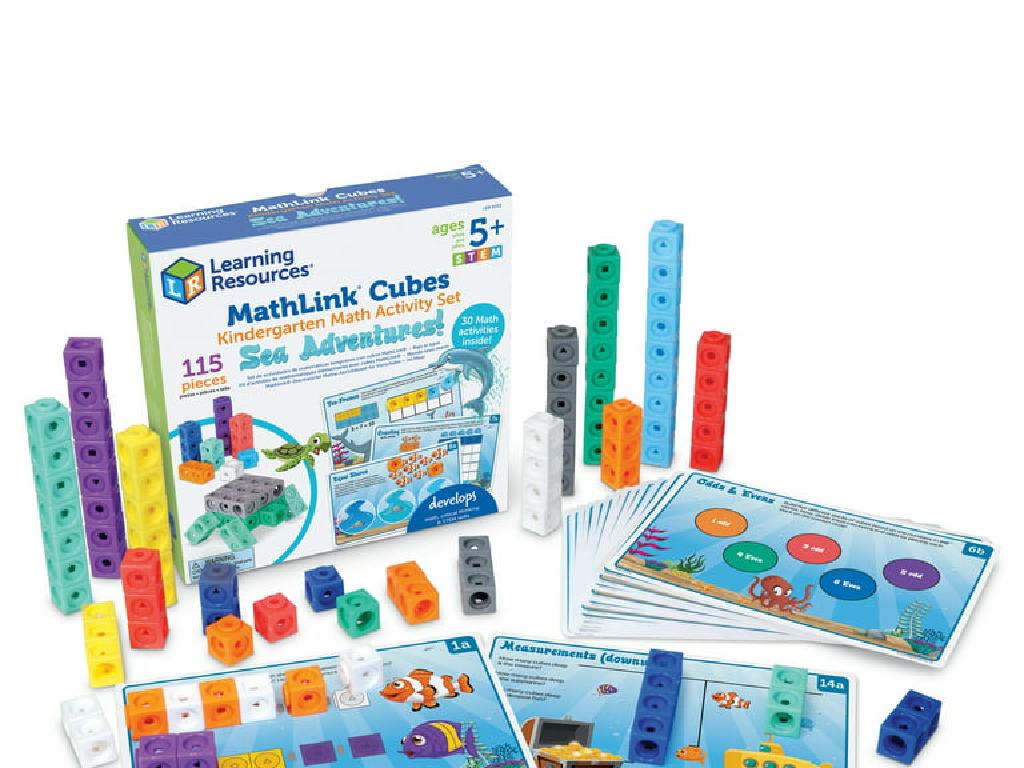Represent Numbers - Up To 10
Subject: Math
Grade: Pre-k
Topic: Counting To 10
Please LOG IN to download the presentation. Access is available to registered users only.
View More Content
Welcome to Counting!
– Greetings, little mathematicians!
– Today’s focus: Numbers up to 10
– We’ll explore each number from one to ten.
– Counting together: 1 to 10
– We’ll practice counting in a fun way, with claps and smiles!
– Fun with numbers!
– Games and activities to enjoy numbers.
|
This slide is designed to introduce Pre-K students to the concept of counting up to 10. Start the lesson with a warm and enthusiastic greeting to engage the children. Explain that the day’s lesson will be about numbers from 1 to 10. Invite the children to count aloud together from 1 to 10, using claps or other fun actions to make the counting tangible and enjoyable. Incorporate games and activities such as number songs, counting objects, or using fingers to represent numbers to reinforce the concept. The goal is to create a joyful and interactive environment where the children can become familiar with the numbers and feel confident in their ability to count to 10.
What Are Numbers?
– Numbers show quantity
– Numbers tell us how many items we have
– Numbers are part of daily life
– We count toys, cookies, and even our fingers using numbers!
– Explore numbers 1 to 10
– Let’s count together from one to ten
|
This slide introduces the concept of numbers to Pre-K students, emphasizing their role in quantifying objects. Start by explaining that numbers help us determine the quantity of items we have, which is a fundamental math skill. Use everyday examples that children are familiar with, such as counting toys or cookies, to illustrate the use of numbers in daily life. Encourage the children to look around and count items in the classroom or at home. Finally, engage the students in a fun activity by counting from 1 to 10 together, using visual aids like number cards or objects to count. This interactive approach will help them understand and remember the sequence of numbers.
Learning the Number 1
– The number 1 represents a single item
– It’s the first number we learn to count
– Example: One apple
– Think of having one toy to play with
– Show one finger for number 1
– Holding up one finger helps us remember ‘one’
|
This slide introduces the concept of the number 1 to Pre-K students. It’s important to start with tangible examples they can relate to, like one apple, to help them understand the idea of ‘one’. Encourage the students to show one finger, which is a simple and effective way to visually represent the number. This activity helps with number recognition and reinforces the concept of counting. As an extension, you can ask the students to find one item in the classroom or at home, further solidifying their understanding of the number 1.
Learning Numbers 2 to 5
– Understanding numbers 2, 3, 4, and 5
– These numbers follow after 1 and come before 6
– Numbers represent quantity
– For example, 2 apples, 3 cars, 4 blocks, 5 ducks
– Counting objects from 2 to 5
– We’ll count together using toys and pictures
– Practice with fun activities
|
This slide introduces the numbers 2 to 5 to Pre-K students, emphasizing the concept of quantity that each number represents. Start by showing the numbers and saying them out loud. Then, demonstrate with real-life objects like fruits or toys to help children visualize the quantity each number stands for. Engage the class in counting exercises using classroom items or illustrations to reinforce their understanding. For the activity, you can have different stations with sets of 2, 3, 4, and 5 objects for children to count, or use interactive games that require counting these numbers. The goal is to make the learning experience interactive and enjoyable, helping students to grasp the concept of numbers as quantities.
Exploring Numbers 6 to 10
– Understanding numbers 6 to 10
– Numbers after 5: 6, 7, 8, 9, and 10
– Counting helps us with more items
– More than 5? Use these numbers to count
– Let’s count objects from 6 to 10
– Practice by counting toys, fingers, or crayons
|
This slide introduces children to the numbers 6 through 10, building upon their existing knowledge of counting up to 5. Emphasize the concept that these numbers allow us to count a larger quantity of items. Engage the children in a counting activity using familiar objects such as toys, fingers, or crayons to make the learning process interactive and fun. Encourage them to recognize these numbers in different contexts and use various counting strategies, such as counting out loud or pointing to each object as they count. This will help solidify their understanding of the sequence of numbers and the concept of quantity.
Counting Practice: Numbers Up to 10
– Let’s count objects together
– I’ll show you objects to count
– We count only up to 10
– Remember, stop at 10 even if there are more
– Practice makes perfect!
– The more we count, the better we get!
|
This slide is designed to engage Pre-K students in a counting activity. Start by showing them a variety of objects, such as blocks, fruits, or toy cars. Encourage the children to count along with you, reinforcing the concept that the numbers stop at 10. Make sure to count slowly and clearly, pointing to each object as you go. If there are more than 10 objects, use this as an opportunity to teach them about stopping at 10. After counting, ask the children to try counting on their own with the objects in front of them. This activity will help solidify their understanding of numbers and counting up to 10. Provide positive feedback and encouragement to build their confidence in their counting skills.
Matching Numbers with Objects
– Match number to objects
– See 3 apples? Find the number 3.
– Observe and choose the right number
– Count items and pick their number.
– Let’s match numbers together!
– We’ll do it as a class activity!
|
This slide is for a class activity where students will practice matching numbers to a corresponding set of objects. The goal is to help them visually connect the concept of quantity to numerical symbols. Start by showing them a group of objects, then ask them to find the number that represents the quantity of those objects. Encourage participation by guiding them through the process as a group. For example, if there are 5 cars, help them find and match it to the number 5. This activity can be done with various items to keep it engaging. Prepare sets of objects and numbers for the students to work with in pairs or small groups.
Fun with Numbers!
– Numbers: More than counting
– Play games with numbers
– Like ‘Number Bingo’ or ‘Hide & Seek Count’
– Counting game time
– We’ll count objects together in a game
– Ready, set, count!
|
This slide is designed to introduce Pre-K students to the concept that numbers are versatile and can be fun. Emphasize that numbers are not just for counting; they can be used in games, which makes learning them enjoyable. Introduce simple games that incorporate numbers, such as ‘Number Bingo’ where children match numbers on their cards, or ‘Hide & Seek Count’ where they find and count hidden objects. Get the children excited about the counting game you will play, and ensure they are ready to participate. The activity will involve counting various objects together, which will help them understand and represent numbers up to 10. Encourage participation and make sure to celebrate their efforts to foster a positive learning environment.
Class Activity: Number Hunt
– Let’s go on a number hunt!
– Find and count objects up to 10
– Look for pencils, blocks, or books
– Count with your classmates
– Help each other in finding and counting
– How many items did you find?
|
This activity is designed to be a fun and interactive way for Pre-K students to practice counting to 10. Set up the classroom with various objects in plain sight and some that are slightly hidden. Encourage the children to search for these items and count them aloud. They should work in small groups to foster teamwork and ensure that everyone is participating. As they find and count, they can use their fingers to help keep track of numbers. After the hunt, gather the students and discuss what they found, how many of each item, and if they reached up to 10. This will reinforce their counting skills and their ability to represent numbers. Provide guidance and encouragement throughout the activity to keep them engaged.
Great Job Counting!
– Celebrate counting to 10
– Applaud for ourselves
– Let’s clap our hands for our achievement
– Practice is key
– The more we count, the better we get!
– Keep counting every day
– Try counting things at home too
|
This slide is meant to congratulate the students on their achievement of counting to 10. It’s important to celebrate their success to build confidence and encourage a positive attitude towards learning. A big round of applause helps to reinforce their accomplishment. Emphasize the importance of practice in mastering counting skills. Encourage them to practice counting whenever they can, using everyday objects like toys, snacks, or steps. This will help solidify their understanding of numbers and quantity. Remember to keep the mood light and fun, as positive reinforcement is key at this stage of learning.






